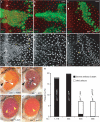Yan, an ETS-domain transcription factor, negatively modulates the Wingless pathway in the Drosophila eye
- PMID: 21869817
- PMCID: PMC3185344
- DOI: 10.1038/embor.2011.159
Yan, an ETS-domain transcription factor, negatively modulates the Wingless pathway in the Drosophila eye
Abstract
We report the identification of yan, an ETS-domain transcription factor belonging to the Drosophila epidermal growth factor receptor (DER) pathway, as an antagonist of the Wingless signalling pathway. We demonstrate that cells lacking yan function in the Drosophila eye show increased Wingless pathway activity, and inhibition of Wingless signalling in yan(-/-) cells rescues the yan mutant phenotype. Biochemical analysis shows that Yan physically associates with Armadillo, a crucial effector of the Wingless pathway, thereby suggesting a direct regulatory mechanism. We conclude that yan represents a new and unsuspected molecular link between the Wingless and DER pathways.
Conflict of interest statement
The authors declare that they have no conflict of interest.
Figures





References
-
- Baonza A, Freeman M (2002) Control of Drosophila eye specification by Wingless signalling. Development 129: 5313–5322 - PubMed
-
- Barolo S, Castro B, Posakony JW (2004) New Drosophila transgenic reporters: insulated P-element vectors expressing fast-maturing RFP. Biotechniques 36: 436–440, 442 - PubMed
-
- Brand A, Perrimon N (1993) Targeted gene expression as a means of altering cell fates and generating dominant phenotypes. Development 118: 401–405 - PubMed
-
- Dasgupta R (2009) Functional genomic approaches targeting the wnt signaling network. Curr Drug Targets 10: 620–631 - PubMed
-
- DasGupta R, Kaykas A, Moon RT, Perrimon N (2005) Functional genomic analysis of the Wnt–wingless signaling pathway. Science 308: 826–833 - PubMed
Publication types
MeSH terms
Substances
Grants and funding
LinkOut - more resources
Full Text Sources
Molecular Biology Databases
Research Materials

